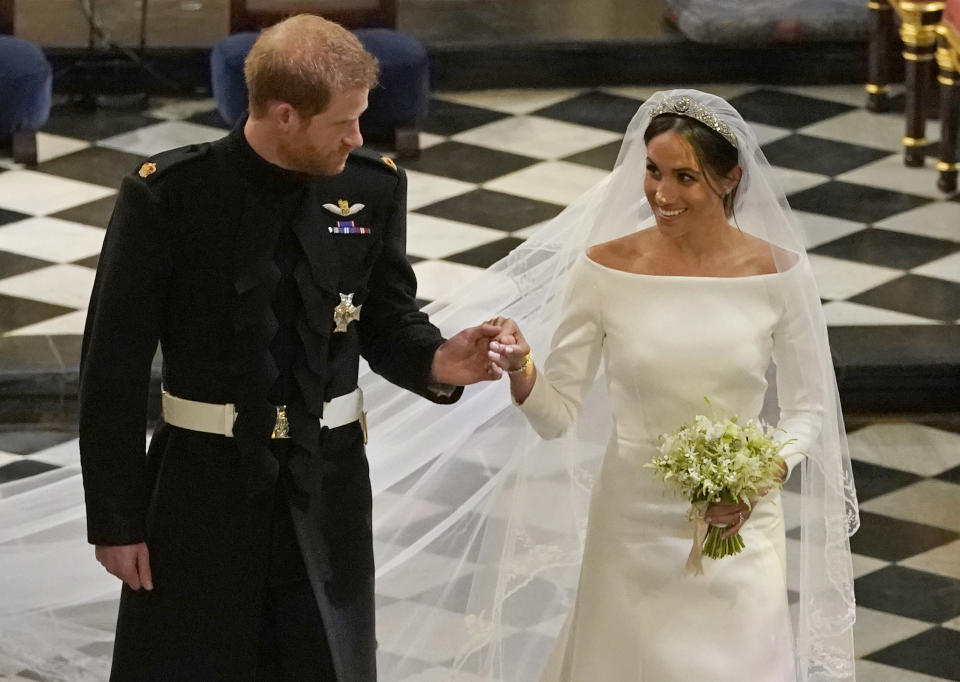Are Harry and Meghan allowed to use a crown emblem on their letters?

Prince Harry and his wife Meghan may be settling into a new life in Los Angeles, but they are still keeping up to date with the charities they supported in the UK.
As well as video messages and calls, the royal couple has been sending letters to charities thanking them for their work in the midst of the coronavirus pandemic.
But the letters have come in for criticism from some royal watchers, particularly those who think the couple should change the monogram symbol at the top of their letters.
Harry and Meghan have their first initials interwoven in a monogram which sits as the header on their letters, with a crown on top.
Some think the couple should get rid of the crown now that they have stepped back as senior royals.
One joked: “Must have leftover stationary. [sic]”
Another said: “They need to take that crown out of that M logo.”
One said: “No royalty-no crown!”

However, the couple appears to be allowed to use the coronet on the top of their monogram despite agreeing to drop their HRH stylings.
In May 2018, the Royal Family announced a new coat of arms had been created for Meghan, and that a coronet had been assigned to her.
At the time, a press release explained: “It is the Coronet laid down by a Royal Warrant of 1917 for the sons and daughters of the Heir Apparent. It is composed of two crosses patée, four fleurs-de-lys and two strawberry leaves.”
Harry’s position as a son of the Heir Apparent has not changed as he stepped back, so the coronet will still be assigned to them both.
Re: The use of Coronet in ones monogram
Sarah & Diana continued to use coronet in their monograms after their divorce, even though both lost their HRH style. pic.twitter.com/pzQmYZjOQ7— Gert's Royals (@Gertsroyals) June 21, 2020
Read more: Prince Harry and Meghan Markle's Archewell trademark application is too vague
Royal blogger Gert’s Royals, a site which regularly writes to royals around the world, pointed out that Harry and Meghan are not the only royals to drop duties and continue using a coronet.
The blogger directed people to letters from Harry’s mother, Diana, and Sarah, the Duchess of York, who both lost their HRH stylings after their divorces from Princes Charles and Andrew respectively.
Despite those divorces and the stripping of their stylings, the letters from Diana and Sarah continued to use coronets.
Princess Beatrice & Eugenie use the coronets of the children of the son of the sovereign in their monograms. Although for Eugenie & Jack’s joint monogram does not use a coronet as he is not a Royal. pic.twitter.com/Q0KUd5zZE9
— Gert's Royals (@Gertsroyals) June 21, 2020
And Princesses Beatrice and Eugenie, who are Prince Andrew’s children, also use coronets in their letterheads.
The sisters have never been working royals, and don’t carry out duties on behalf of the crown.
Interestingly, Eugenie and her husband Jack Brooksbank, don’t have a crown on their joint monogram.
However this is likely to be because Eugenie was not given a new title by the Queen on her wedding day, as she is a woman, and they are only bestowed on male heirs.
A 2nd reply from Duchess Sarah for the Christmas Letter I sent. This one thanking me for the congratulations on Princess Beatrice's engagement I had mentioned in my Christmas Letter. https://t.co/ZdYUGrPF4i pic.twitter.com/CPXK3cKNMs
— Gert's Royal Replies (@GertsReplies) March 24, 2020
Read more: Why are Prince Harry and Meghan Markle stepping back as senior royals?
It does appear that Sarah Ferguson has stopped using the same monogram now, as newer replies from her feature an ‘S’ design without a coronet on top.
Harry and Meghan no longer use the Sussex Royal brand, and mothballed the corresponding Instagram account at the end of March when they stepped back.
However with the launch of their new organisation, Archewell, on hold, the couple could opt to swap their royal emblem once it is up and running.
Until then, they are likely to keep using the former logo by which we recognise their correspondence.



